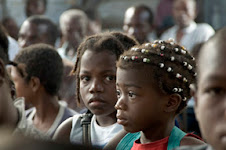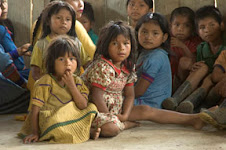Quibdó, El Chocó, Colombia
July 31, 2012
Waiting for the "Paro Minero"
(What follows is an informal note—some things thrown
together from notes I have sent to friends, from scribblings in the first
stages of an article I am going to write about gold mining in El Chocó, and
various thoughts. It seems too long for the blog, though maybe…and for now,
it’s in English, so only going to people who can read English (or who I think
can read English).
[No photographs yet—I hope to post some soon. And the Spanish translation will have to wait a while.]
Tomorrow, August 1, is a Hemispheric Day of Action against
Transnational Mining (though hemispheric sounds a little grand; there will be
activities in at least four countries, maybe more). In Canada, it’s directed
against the unfortunately very dirty role that Canada has played in this area.
]
Here in Colombia, the issue is the push to bring
transnational the mining companies into various area, some of which have been
protected from this type of exploitation in the past. For a number of reasons,
the issue has been posed as “small-scale” Colombian miners versus
transnationals. While there is some truth to this description, and it’s
certainly true that the “small-scale” miners will be wiped out if this push
succeeds, it’s also true that at least here in Chocó, they have also been
responsible for a lot of damage, both environmental and social.
Tomorrow was going to be a one-day work stoppage, with
marches and demonstrations in a number of cities—except in El Chocó, where the
strike (“paro minero”) was declared for an undefined period of time…and we
heard that communities near Quibdó were advised to do food shopping in
advance. This afternoon I heard that
there has been some sort of agreement between miners and the national
government. They will no longer be referred to or treated as “illegal,” but
rather “informal.” Threating them as illegal was a government ploy, part of
their program of supporting the arrival of multi-nationals. But, in fact, in El
Chocó, much of their behavior has been illegal…But this doesn’t justify
bringing in the big mining forms, and all the damage they are going to do.
So just today, the marches and demonstrations planned for
tomorrow were suspended—expect in El Chocó, where the miners’ federation has
not agreed to the new arrangement.
There are lots of rumors flying around, and a lot of fear.
Will this be a huge demonstration? Will there be violence? From what I can see,
it doesn’t seem likely, and people I have confidence in think an effort is
being made to calm things down among the miners. But since Monday,
downtown has been filling up with miners—easy to recognize, actually, they’re
mostly Paisas with boots on. We’re expecting a lot of barequeros to come to the
march—some because they identify with the miners, some because they’re being
paid to come, some perhaps because they are being intimidated—perhaps with not
being let back into the mines, or perhaps with violence.
So what’s behind all this?
The big issue here is not so much the
TLC or FTA, but extractive industries, especially mining. The big transnational
mining companies have their eyes on the Pacific, as well as other places in
Colombia, and they are getting government concessions. The communities are
divided on this issue, very deeply and painfully. Some people see this as the
economic hope they were looking for, but most people see it as a terrible
danger to them and the forest. Some of the leaders, including leaders of
COCOMACIA, were clearly bought by the companies...
Colombia is a country rich in
minerals—gold, platinum, copper, coal, and more, without mentioning the
emeralds, which have the colorful distinction of being traded on the street in
one important downtown Bogotá corner—like diamonds in New York City. But it’s
gold that has the richest history. El Chocó has always been an area of “bareque”
(artisanal mining), which here, as it’s panning, is called “washing the mine
“lavar mina”). And since the conquest, gold has played an important economic
role. Indigenous cultures mined for millennia, but this is another history,
also very interesting—and it is the history recounted in the Museo del Oro,
where the modern struggles of miners and laborers and communities are not presented. Today, the indigenous communities that are close to productive rivers mine in very much the same way as the Sfro communities, and are in the same mining economy.
For generations, families in the
Afro-Colombian communities have “mined” for gold—really, panned for gold in the
rivers and quebradas. But this was always oart of a range of activities that
made up the family economy. Gold was the main source of money (along with some
crops produced for sale, or excess fish) for things that had to be
purchased—cloth, tools, rifles, salt, household goods—but the rest was an
economy outside the area of exchange of money—planting on the land, fishing,
hunting. They lived poor in money, but in many ways they lived well (One friend
has pointed out that the terrible problem of unemployment is a new one—as
recently as thrity years ago, there were no jobs, but there was little
unemployment, because people lived off their land).
Fifteen or twenty years ago the
“retors”—big backhoes that were already operating in other areas, including the
southern rivers of El Chocó, but not in the Río Atrato basin, began to operate
here. They are called “small-scale miners,” though really, “small-scale” is a
relative term—compared with what existed before, they’re huge.
In these fifteen years or more, the so-called “small-scale” miners have done a lot of damage with their backhoes—both to the forest and to the social structures and what was once a varied family economy. I’m trying to write about this. But one problem is that the artisanal miners—the barequeros—see them as their partners, despite the damage they have caused. I think I understand this; working in the pits created by the “retros” promises a lot more gold, but in reality the people abandon much of their traditional economic activity and devote themselves to a practice that sinks them deeper into the cash economy without providing very much money for most of them.
But now these “small” operators are
threatened by the coming of the transnationals. They see themselves as victims,
and they will be. But as one source says, probably the big difference is that
the big companies will just destroy the forest faster...In any event, right now
people who have been very critical of the miners are now making common cause
with them against the big transnationals. This is President Santos’ big
plan—extractive industries will be “locomotive” of Colombian economic
development. But last year, I heard a knowledgeable activist say in a big
meeting that it won’t be a locomotive for El Chocó, but a steamroller...
One of the sources of the militancy here in El Chocó is that in addition to the “small miners” themselves, there are some underground interests that are very important. The two things I’m going to mention are never discussed in any of the meetings, interviews, etc., but are widely discussed by very knowledgeable people here. First, there is a suspicion on the part of some people that gold mining is used to launder coca money. Could be...
One of the sources of the militancy here in El Chocó is that in addition to the “small miners” themselves, there are some underground interests that are very important. The two things I’m going to mention are never discussed in any of the meetings, interviews, etc., but are widely discussed by very knowledgeable people here. First, there is a suspicion on the part of some people that gold mining is used to launder coca money. Could be...
The other point is clearly true. In
this area, at the very least the FARC guerrillas get paid off—they “tax” or
“extort” the miners, depending on your perspective. Some of the people in whom
I have a lot of confidence—and whom I’m not going to name, for obvious
reasons—tell me that some of the mines are actually owned by the FARC. In any
event, it’s clear that they have a lot to lose in the unequal struggle between
the transnationals and the “small miners.” Everyone feels it’s obvious that the
guerrillas are behind the resistance of the Chocó miners to compromises reached
by others.
There will certainly be barequeros in
tomorrow’s march. But why are they here? Some undoubtedly because they identify
with the “small miners.” Some because they are being paid to come. Sand some
because they are afraid that if they don’t come, they will lose the ability to
enter the pits in the future. Whether there is real intimidation it’s
impossible to say…
Well, we’ll see what happens tomorrow…
Meanwhile, a new flyer has been circulating threatening a
new wave of “social cleansing,” which means killing thieves, drug-dealers, and
“deviants.” In the leaflet, the anonymous issuers of the threat apologize in
advance for the innocents who will be wrongly killed! While nobody likes the
level of crime and drugs around here, this is not about freeing the population
from crime, but about terrorizing them…
If you want some images of some of the damage done by the
“retros,” and “baregueando” in the pts, hyou can check out the four “galleries”
at: http://www.pbase.com/stevecagan/goldmines
I almost forgot something about "paros"-- —they aren’t quite like strokes as we know them. When I got to Quibdó a few weeks ago, indigenous communities were in a paro along the road that leads from Quibdó towards the neighboring department of Antioquia, and there eventually to Medellín.
But a paro on the way didn’t mean that they were boycotting the highway, but that they were stopping traffic on the way—no one could use it. It lasted over a week—not quite long enough to cause shortages in Quibdó, but long enough to piss people off…
Similarly, a serious paro here could mean not just that the miners had stopped working, but that they expect everyone else to stop working as well. It’s likely that they will just have a peaceful march tomorrow and then things will return to normal on Thursday or Friday. Meanwhile commerce will stop in the city center.
but it’s also possible that this could go on for a while, and really disrupt life here—not likely, but possible. Against that possibility, people started buying groceries this afternoon. As I left the center, about 6, the place was just one big traffic jam, as people bought in the many stores in the center. I was carrying a lot, nd anyway the camera I was carrying decided to die on me suddenly, so all I got was a few silent iPhone videos, but it was impressive.
When I got to the neighborhood where I’m staying (Jardín, for those who know Quibdó), I stopped at the local little supermarket, usually quite slow and lazy, now filled with people, though they weren’t exactly emptying the shelves—I bought a little extra bread and beans and eggs and oranges, just in case.
Even at that intersection, there was a terrific traffic jam that required traffic cops to unsnarl. I asked the owner if they are going to open tomorrow, and he said, “We don’t know yet—it depends on the situation tomorrow.”
Hmm..well, we’ll see


No comments:
Post a Comment